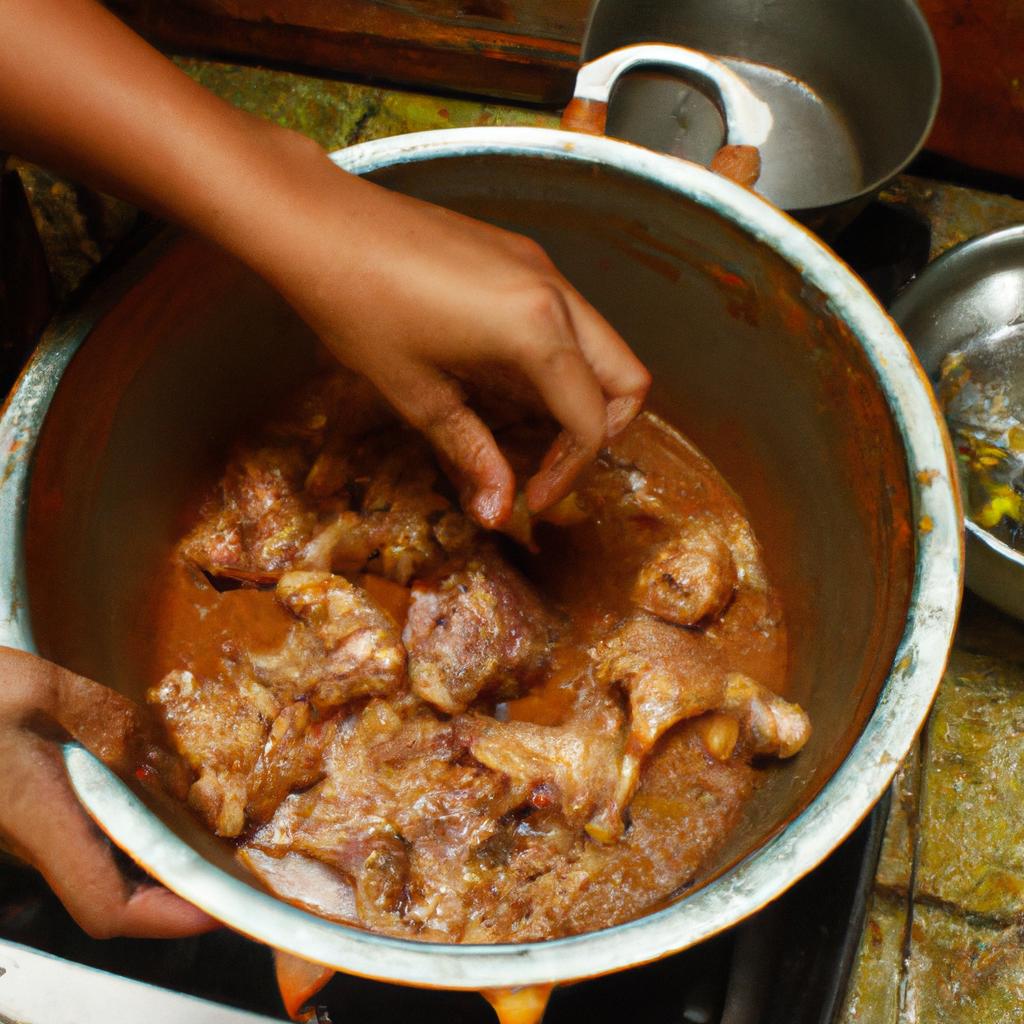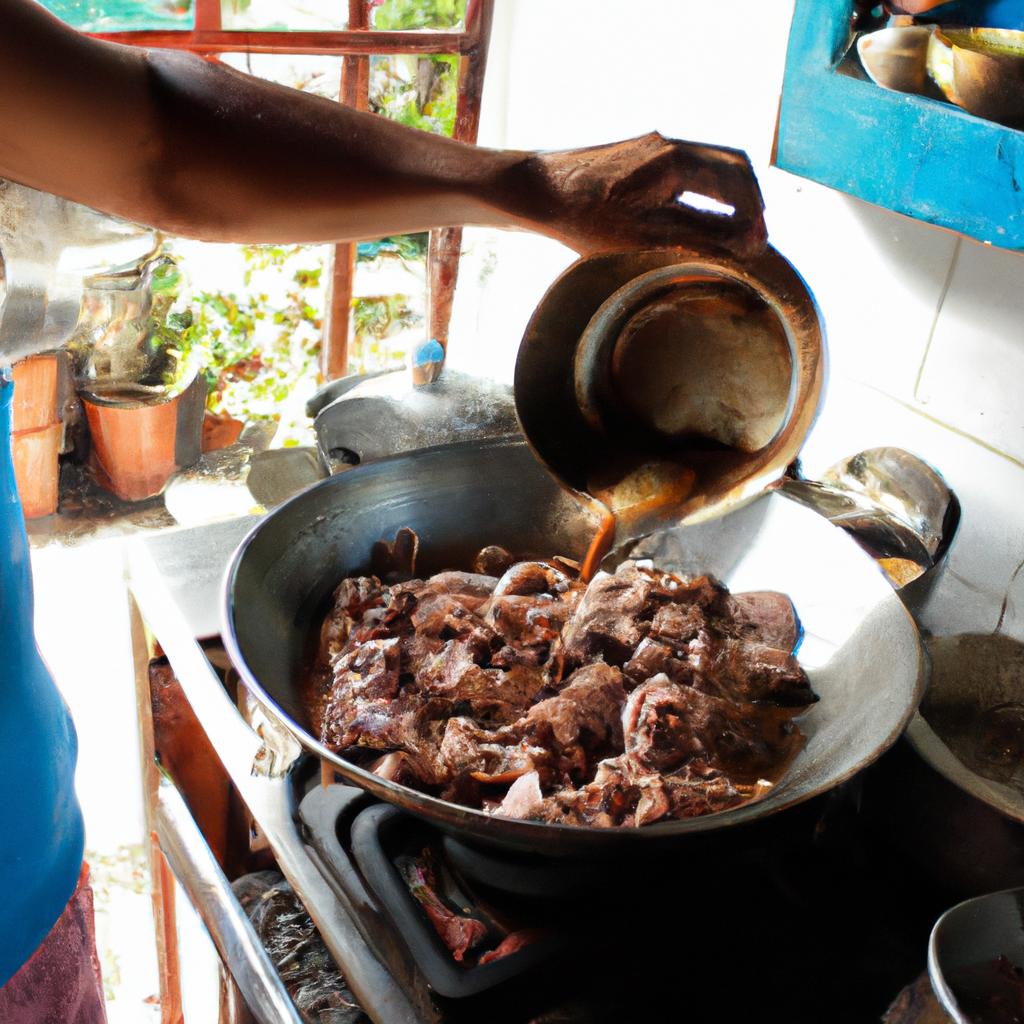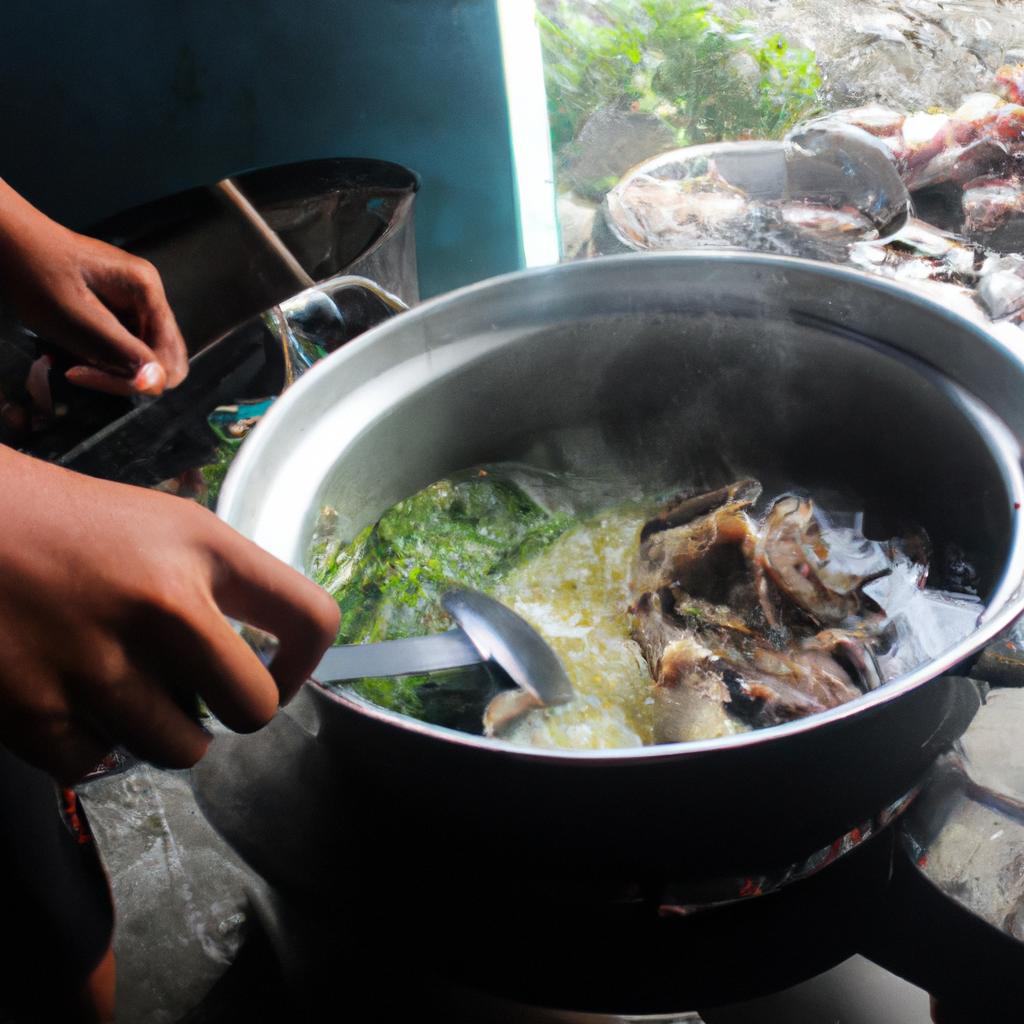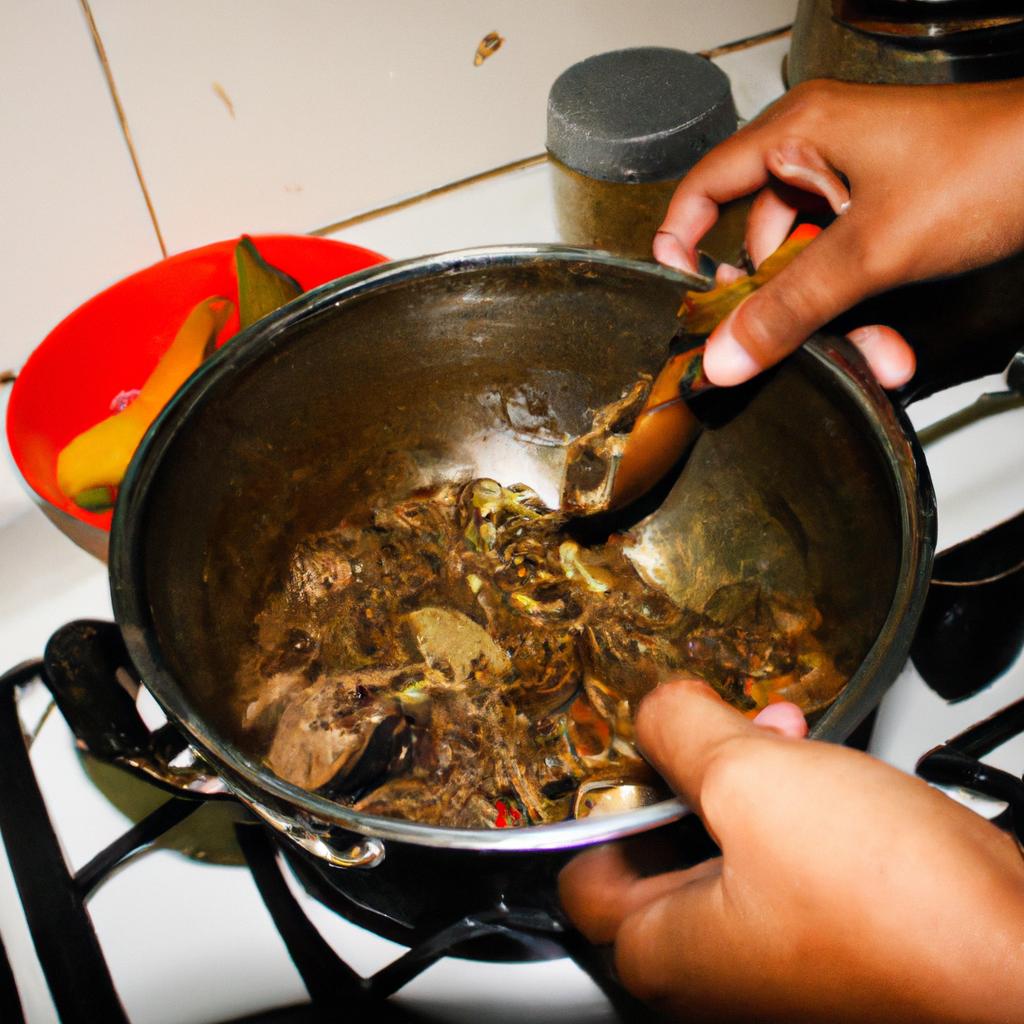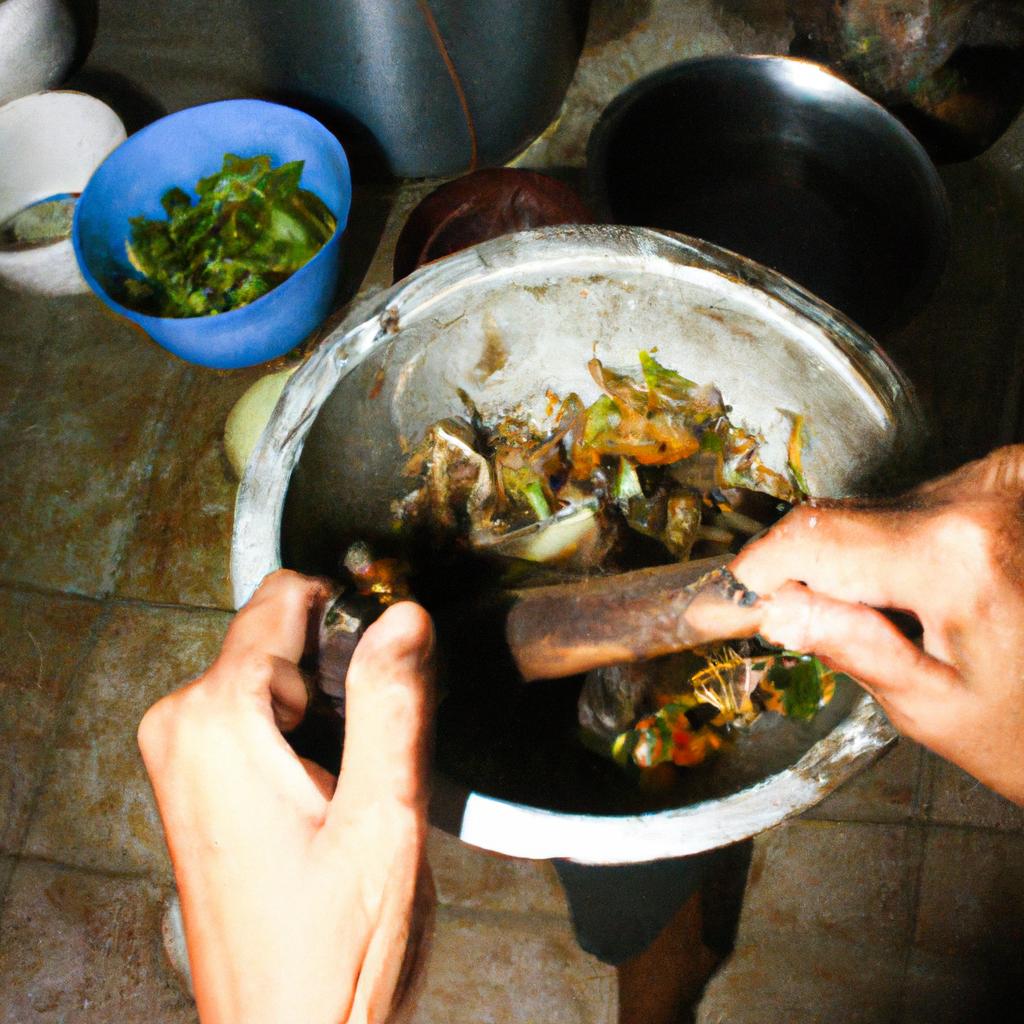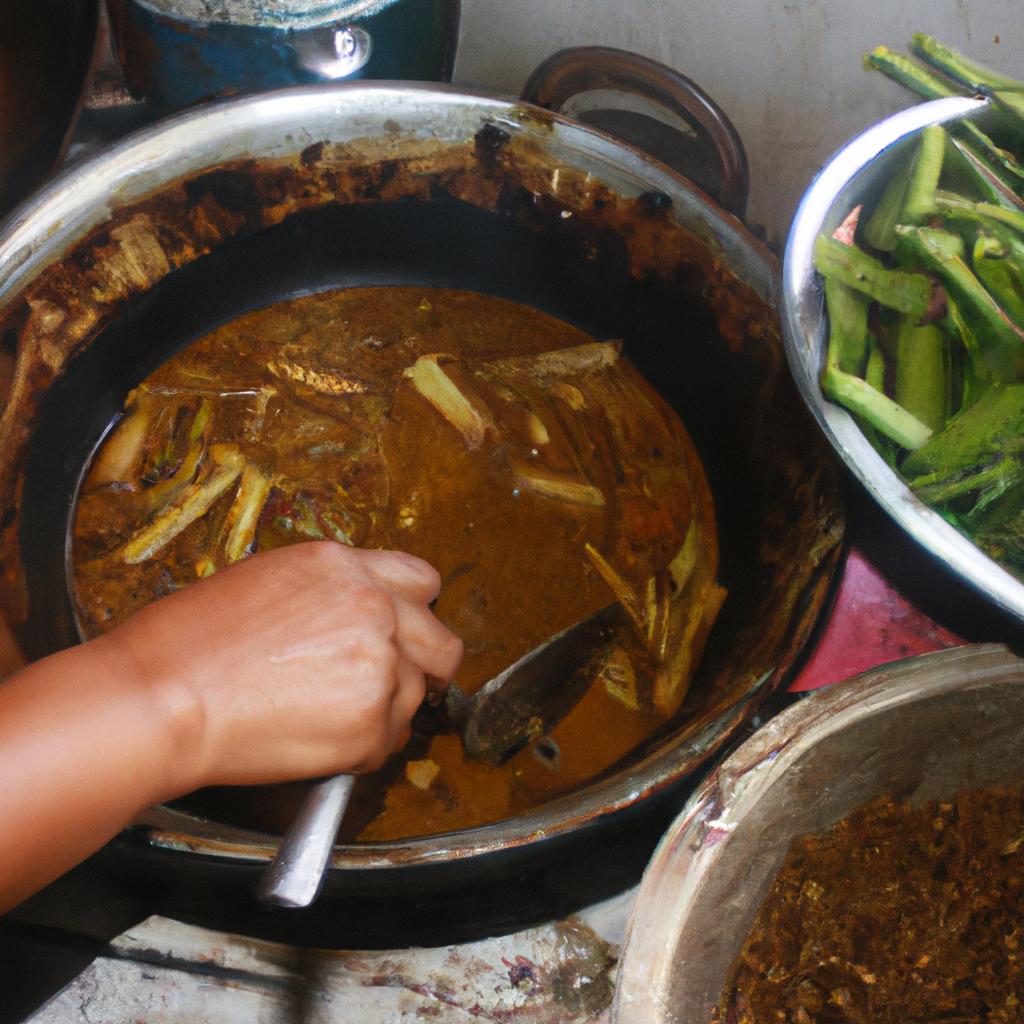Chicken Adobo is a beloved culinary masterpiece that holds a special place in Filipino cuisine. This delectable dish, comprised of succulent chicken marinated and simmered in a blend of soy sauce, vinegar, garlic, and spices, has captured the hearts and palates of both locals and foreigners alike. Its unique combination of flavors creates an explosion on the taste buds that leaves a lasting impression. For instance, imagine John, an adventurous traveler who embarks on a gastronomic journey to explore different cuisines around the world. During his visit to the Philippines, he encounters Chicken Adobo for the first time and is immediately captivated by its savory aroma and tender texture.
The purpose of this article is to delve deeper into Chicken Adobo as a cultural icon and examine its significance within Filipino society. By exploring its origins, preparation methods, and variations across regions, we can gain valuable insights into the rich culinary heritage of the Philippines. Furthermore, we will analyze how this traditional delicacy reflects the country’s history, social dynamics, and family traditions. Through this examination, we aim to shed light on why Chicken Adobo continues to hold such reverence among Filipinos while also gaining recognition as one of the must-try dishes worldwide. So let us embark on So let us embark on a flavorful journey through the world of Chicken Adobo, unraveling its secrets and understanding why it has become an enduring symbol of Filipino culture.
To begin our exploration, we must first understand the origins of Chicken Adobo. This dish traces its roots back to pre-colonial times when Filipinos employed vinegar as a means of preserving meat in the tropical climate. Over time, this preservation technique evolved into a culinary tradition that combined indigenous ingredients with influences from Chinese and Spanish cuisines.
Next, let’s delve into the preparation methods that make Chicken Adobo so unique. The key to achieving its distinct flavor lies in marinating the chicken in a mixture of soy sauce, vinegar, garlic, black peppercorns, and bay leaves. This marinade infuses the meat with tangy and savory notes while tenderizing it for hours or even overnight. Once marinated, the chicken is then simmered in the same marinade until it becomes succulent and infused with flavors.
Interestingly, despite being known as Chicken Adobo, this dish can also be prepared using other meats such as pork or even seafood like squid or shrimp. Each variation brings its own twist to the classic recipe, offering diverse taste experiences across different regions of the Philippines.
Speaking of regional variations, let’s explore how Chicken Adobo differs from one place to another within the archipelago. In some provinces, coconut milk is added to create a creamier version known as “Adobong Puti.” Meanwhile, in others like Batangas province, they have their own take called “Adobong Dilaw” which incorporates turmeric for an earthy flavor and vibrant yellow color. These regional adaptations showcase not only the diversity within Filipino cuisine but also reflect local ingredients and cultural influences.
Beyond its delicious taste and versatility in cooking methods, Chicken Adobo holds deep cultural significance among Filipinos. It serves as a representation of Filipino resilience and adaptability, as it has withstood the test of time and various foreign influences. The simplicity of its ingredients also reflects the resourcefulness and practicality ingrained in Filipino culture.
Moreover, Chicken Adobo is often served during special occasions and family gatherings, making it a symbol of togetherness and celebration. It brings people together around the dining table, creating cherished memories and reinforcing familial bonds. Its presence on festive occasions like fiestas or birthdays signifies abundance, warmth, and hospitality.
In recent years, Chicken Adobo has gained international acclaim due to its robust flavors and cultural significance. Chefs around the world have embraced this dish, incorporating their own interpretations into their menus. This global recognition not only elevates Filipino cuisine but also fosters cross-cultural understanding by introducing new audiences to the rich flavors of the Philippines.
In conclusion, Chicken Adobo stands as an emblematic dish that embodies the essence of Filipino cuisine. Its ability to captivate both locals and foreigners alike lies in its mouthwatering blend of flavors, historical roots, regional variations, and cultural significance. Whether enjoyed at a humble kitchen table or in a high-end restaurant overseas, Chicken Adobo continues to be a beloved culinary masterpiece that holds a special place in Filipino hearts worldwide.
History of Chicken Adobo
Chicken Adobo, a popular Filipino dish known for its tangy and savory flavors, has a rich history that dates back centuries. To understand the origins of this beloved delicacy, it is important to explore various cultural influences and regional variations.
One fascinating example that showcases the diverse nature of Chicken Adobo is the case of two neighboring provinces in the Philippines: Pampanga and Batangas. In Pampanga, located in Central Luzon, locals traditionally cook their adobo with vinegar as the primary souring agent. Meanwhile, in Batangas, situated in Southern Luzon, they prefer using soy sauce instead. This stark contrast highlights how different regions have developed their own unique takes on this classic dish.
- A testament to culinary resilience:
- Despite colonization and foreign influences over time, Chicken Adobo remains deeply rooted in Filipino culture.
- Nostalgia-inducing comfort food:
- The aroma of simmering adobo can transport Filipinos to memories of home-cooked meals shared with loved ones.
- Symbolic representation of unity:
- By bringing together ingredients like vinegar, soy sauce, garlic, and spices, Chicken Adobo represents the harmonious blending of various cultures within the Philippines.
- Cultural pride and identity:
- For many Filipinos around the world, preparing and sharing Chicken Adobo allows them to celebrate their heritage while introducing others to their vibrant cuisine.
Additionally, let us incorporate a table showcasing some key elements related to Chicken Adobo:
| Region | Key Ingredients Used | Notable Variations |
|---|---|---|
| Pampanga | Vinegar | Use chicken liver |
| Batangas | Soy Sauce | Include pineapple chunks |
| Visayas | Coconut milk | Incorporate turmeric |
| Mindanao | Annatto seeds | Add coconut vinegar |
As we delve deeper into the history of Chicken Adobo, it becomes evident that this dish is not solely about its delectable taste. It embodies cultural resilience, nostalgic memories, and a sense of unity among Filipinos worldwide. In the subsequent section, we will explore the various ingredients used in preparing this iconic delicacy.
Ingredients used in Chicken Adobo
Chicken Adobo, a beloved dish in Filipino cuisine, has a rich history that dates back centuries. This section will delve into the origins and evolution of Chicken Adobo, highlighting its cultural significance and enduring popularity.
To illustrate how deeply ingrained Chicken Adobo is in Filipino culture, let’s consider a hypothetical scenario: Maria, a young Filipina living abroad, craves a taste of home. She decides to prepare Chicken Adobo using her grandmother’s recipe. As she follows the traditional cooking method passed down through generations, Maria reflects on the historical roots of this iconic dish.
The history of Chicken Adobo can be traced back to pre-colonial times when indigenous tribes used vinegar as a natural preservative for meat. The Spanish colonization period introduced additional ingredients like soy sauce and garlic, which further enhanced the flavor profile. Over time, Chinese influences brought about variations such as adding sugar or bay leaves to create distinct regional styles.
To better understand the cultural significance of Chicken Adobo, here are some key aspects:
- Adaptability: Chicken Adobo has become synonymous with Filipino identity due to its adaptability across different regions and households. Each family adds their unique touch by adjusting ingredient proportions or incorporating local spices.
- Comfort food: With its savory aroma and tender meat soaked in flavorful marinade, Chicken Adobo provides comfort during family gatherings or moments of nostalgia for Filipinos around the world.
- Symbolism: Beyond being just a dish, Chicken Adobo carries societal symbolism related to resilience and resourcefulness. Its ability to preserve meat without refrigeration historically made it an essential survival food.
- Aromatic memories wafting from simmering pots
- Warm embraces shared over steaming plates
- Nostalgic flavors transporting one back to childhood
- Connection between tradition and modernity through culinary heritage
Now let’s evoke further emotion with a table showcasing various regional styles of Chicken Adobo:
| Region | Key Ingredient | Unique Twist |
|---|---|---|
| Luzon | Soy sauce, vinegar | Added sugar for sweetness |
| Visayas | Vinegar, garlic | Incorporation of coconut milk |
| Mindanao | Coconut vinegar, chili | Use of turmeric for color |
As we move forward to explore the traditional method of cooking Chicken Adobo, it is important to appreciate how this dish has evolved over time while retaining its cultural essence. By examining the techniques and nuances behind the preparation process, we can gain a deeper understanding of Filipino culinary traditions.
Traditional method of cooking Chicken Adobo
Having explored the various ingredients used in Chicken Adobo, let us now delve into the traditional method of cooking this flavorful Filipino dish. To illustrate its preparation process, we will consider a hypothetical case study involving a family gathering where several generations come together to prepare and enjoy Chicken Adobo.
Case Study: Imagine a warm Sunday afternoon at Lola’s house, where she gathers her children and grandchildren for their weekly tradition of preparing Chicken Adobo. The aroma of vinegar and soy sauce fills the air as they follow the time-honored steps passed down through generations.
The traditional method of cooking Chicken Adobo involves a few key techniques that contribute to its uniqueness:
- Braising: The first step is to sauté the chicken pieces in garlic until lightly browned. This imparts a rich flavor while ensuring even cooking throughout.
- Simmering: Once the chicken has been browned, it is then simmered in a mixture of vinegar, soy sauce, bay leaves, and peppercorns. This slow-cooking process allows the flavors to meld together and infuse into every bite.
- Marinating: After simmering, some families prefer to marinate their cooked adobo overnight or for several hours before reheating and serving it again. This additional step intensifies the flavors and tenderizes the meat further.
- Reduction: As the liquid simmers with the chicken, it slowly reduces to create a thickened sauce that coats each piece perfectly.
- Nostalgia-inducing aromas waft through the kitchen as multiple generations gather around.
- Mouthwatering anticipation builds with every step taken towards creating an authentic Chicken Adobo experience.
- Shared laughter echoes while stories are exchanged amidst chopping onions and mincing garlic.
- An overwhelming sense of pride arises from preserving cherished family traditions handed down over time.
| Ingredient | Purpose | Flavor Profile |
|---|---|---|
| Chicken | Main protein source | Savory, tender |
| Vinegar | Key acid component | Tangy, acidic |
| Soy Sauce | Salty and savory seasoning agent | Umami-rich |
| Garlic | Aromatic bulb for added depth | Pungent, earthy |
With the traditional method of cooking Chicken Adobo explored, our next section will focus on the delightful variations of this Filipino delicacy. We will discover how different regions and families have put their unique spin on this beloved dish while still maintaining its essence. So let’s embark on a culinary journey through the diverse adaptations of Chicken Adobo.
Variations of Chicken Adobo
As we delve further into the realm of Filipino cuisine, it becomes evident that Chicken Adobo is not merely confined to a single recipe. The versatility and adaptability of this beloved dish have led to numerous regional variations across the Philippines. These variations showcase the diverse culinary traditions present within the country, adding unique flavors and textures to an already delicious meal.
To illustrate this point, let’s consider one example – the Bicol Express Chicken Adobo. Hailing from the Bicol region in the southern part of Luzon Island, this variant infuses traditional adobo with elements inspired by another popular local dish called Bicol Express. By incorporating coconut milk, chili peppers, and other aromatic spices into the marinade, Bicol Express Chicken Adobo offers a rich and spicy twist on the classic recipe.
The ingenuity behind these adaptations reflects both cultural influences and personal preferences. Here are some notable variations of Chicken Adobo found throughout the Philippines:
- Visayan-style adobo features vinegar as its primary souring agent but adds turmeric for enhanced flavor.
- Batangas-style adobo includes soy sauce alongside vinegar for added depth of taste.
- Pampanga-style adobo incorporates sugar or banana ketchup to create a slightly sweeter profile.
- Ilocano-style adobo omits soy sauce entirely, resulting in a lighter-colored dish that highlights the natural tanginess of vinegar.
This variety not only adds excitement to our taste buds but also provides insight into how different regions embrace their distinct culinary identities through small yet significant modifications.
In exploring these various iterations of Chicken Adobo, we begin to appreciate how adaptable and customizable this dish truly is. From spicier versions like Bicol Express Chicken Adobo to milder renditions like Ilocano-style adobo, every variation tells a story about its origins and showcases the creativity inherent within Filipino cooking traditions.
Moving forward, let us now delve into the health benefits that Chicken Adobo offers, underscoring its appeal beyond just its delectable taste.
Health benefits of Chicken Adobo
Variations of Chicken Adobo Explored
To further understand the versatility and cultural significance of chicken adobo, let us delve into the varied ways in which this Filipino delicacy is prepared. By exploring different regional adaptations and ingredient substitutions, we can gain a deeper appreciation for the rich tapestry that makes up this beloved dish.
One intriguing variation worth mentioning is the use of coconut milk as an additional ingredient in some recipes. This creamy twist adds a subtle sweetness to balance out the tanginess of the vinegar-based marinade. For example, in Mindanao, a region known for its abundant coconut plantations, locals often incorporate coconut milk into their adobo preparation, resulting in a richer and more indulgent flavor profile.
Another interesting adaptation involves substituting traditional soy sauce with tamari or liquid aminos. These alternatives are gluten-free options that cater to individuals with dietary restrictions or preferences. In recent years, there has been a growing awareness and demand for gluten-free ingredients, leading many home cooks and restaurants to experiment with tamari or liquid aminos as substitutes while still retaining the essence of authenticity.
Furthermore, some creative chefs have explored fusion variations by incorporating elements from other cuisines. One such example is “adoburrito,” where shredded adobo-infused chicken is wrapped in a tortilla along with Mexican-inspired fillings like rice, beans, salsa, and guacamole. This blending of flavors showcases how culinary innovation can create exciting hybrids while paying homage to traditional dishes.
The adaptability of chicken adobo extends beyond just these examples; it continues to evolve across regions and generations. To highlight this diversity visually:
- The comforting aroma wafting from simmering pots
- The sizzle as succulent pieces of chicken are seared
- The vibrant colors of spices coming together harmoniously
- The anticipation felt before taking that first flavorful bite
These sensory experiences evoke emotions ranging from nostalgia to curiosity, cementing chicken adobo’s place as a beloved national dish.
Now, let us turn our attention to the popular accompaniments for chicken adobo and how they enhance the overall dining experience.
Popular accompaniments for Chicken Adobo
Chicken Adobo, a Filipino delicacy known for its unique blend of flavors and tender meat, has been enjoyed by people around the world. In the previous section, we explored the health benefits of this dish. Now let us delve into some popular accompaniments that complement Chicken Adobo perfectly.
Imagine sitting down at a traditional Filipino feast, with plates filled to the brim and mouths watering in anticipation. As you take your first bite of Chicken Adobo, the tangy and savory taste dances on your palate. To enhance this delightful experience further, consider pairing it with some of these delectable accompaniments:
-
Steamed Rice: A staple in Filipino cuisine, steamed rice is a perfect match for Chicken Adobo’s robust flavors. The fluffy texture and neutral taste provide a balance to the rich adobo sauce, allowing each ingredient to shine through.
-
Atchara: This pickled relish made from grated unripe papaya adds a refreshing contrast to the richness of Chicken Adobo. Its tangy flavor and crunchy texture cleanse the palate between bites, making every mouthful feel like an adventure.
-
Sinigang Soup: Known for its sour broth infused with tamarind or other souring agents, sinigang soup complements Chicken Adobo exceptionally well. The contrasting flavors create a harmonious combination that tantalizes taste buds and leaves one craving more.
-
Ensaladang Talong: Made from grilled eggplants mixed with tomatoes, onions, vinegar, and soy sauce; ensaladang talong provides a fresh and vibrant element to accompany Chicken Adobo. The smoky flavor of roasted eggplant combined with zesty dressing creates a delightful contrast to the adobo’s richness.
Now let us explore how these accompaniments compare based on their key characteristics:
| Accompaniment | Flavor Profile | Texture | Pairing Strength |
|---|---|---|---|
| Steamed Rice | Neutral, subtle | Soft | Versatile |
| Atchara | Tangy, crunchy | Crisp | Refreshing |
| Sinigang Soup | Sour, savory | Liquid | Complementary |
| Ensaladang Talong | Smoky, zesty | Crunchy | Contrasting |
Each accompaniment brings a unique element to the table that complements Chicken Adobo in its own way. Whether you prefer the comforting familiarity of steamed rice or the tangy zest of atchara, there is an accompaniment to suit every palate.
Incorporating these accompaniments not only enhances your dining experience but also provides a glimpse into Filipino culture and culinary traditions. By exploring different combinations and creating your own perfect pairing, you can truly savor the essence of this beloved Filipino dish. So go ahead, experiment with these accompaniments and elevate your next Chicken Adobo feast to new heights!

